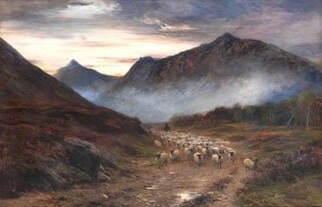The Peaks of Arran
|
Research by Marjorie Gregson and Veronica McDonnell
|
The Peaks of Arran engraving was published by Frost and Reed Bristol in 1903.
|
ARTIST
John MacWhirter was born in Edinburgh in 1839 to George MacWhirter, a paper manufacturer, and his second wife, Agnes Laing. He was the fourth of six children and his sister, Agnes, was a noted artist of still life He was eleven when his father died and was apprenticed at 13 to booksellers, Oliver and Boyd. However, because of his love of art he broke his articles after five months and enrolled at the Trustees’ Academy. There he received excellent tutelage and spent long hours sketching outdoors and studying nature. Making rapid progress he had, at the age of 14, a picture entitled 'Old Cottage at Braid' exhibited at the Royal Scottish Academy. As a young man he visited many countries in Europe as well as the USA in search of subject matter. In 1864, at the age of 25, he was elected Associate of the Royal Scottish Academy. In 1867 he moved to London exhibiting at the Royal Academy until 1904. In 1879 he was elected ARA and in 1893 RA . MacWhirter was influenced by Millais and the Pre-Raphaelites but later adopted a more sweeping style. His preference was for peaceful scenes, many of Scotland or with a poetic theme. He illustrated books, as well as publishing his own, such as “Landscape Painting in Watercolour“. “In 1900 Mr MacWhirter published a book 'Hints to Students on Landscape Painting in Water-Colour' and this is a useful commentary upon his own ideals and methods. He begins with advising the pupil 'always to carry a notebook', and this was his invariable rule. 'You cannot train your memory too soon. . . . Take rapid notes of all sort of things. . . . You should sit down for days (or weeks if you like) before a tree or a root of a tree, and get all the detail and beauty you can into your drawing. Paint also ferns, mosses, bits of stick, smooth and rough stones, rocks etc. Study flowers especially. . . . If you continue filling your note-books with studies such as I have indicated, as well as with studies of clouds, mountains etc you will be able with the knowledge thus acquired to paint a distinct impression of a scene which has passed away". He died in St Johns Wood, London, of bronchitis in 1911. A prolific artist, his work is to be found in many British Collections. DONOR Catherine Stead,1871-1960, was one of four children born in Ramsbottom, Lancashire to William Stead (c1830-1882) and Mary, nee Diggle. He was the son of James Stead (1786-1855) and Catherine, nee Kirk (1794-1858). William was a loom and cotton manufacturer and Catherine, as shown on censuses, lived on private means. In 1939 records show her living at 26 Rowsley Road with Annie W Gore, a companion help and Edith Lockwood, a maid. She never married and when she died in Lytham St Annes, she left £11,937, a considerable sum, worth over £400,000 today (2020). Note: Catherine Stead presented three engravings to the Collection. Two of them, presently unlocated, were by Sir Luke Fildes RA, entitled Daughter of the Ghetto and Daughter of the Lagoons, the original painting is in the Warrington Museum and Art Gallery. |
 The oil painting by MacWhirter from which the engraving was produced is called 'Glen Sannox, Arran' and is owned by Angus Council. The oil painting by MacWhirter from which the engraving was produced is called 'Glen Sannox, Arran' and is owned by Angus Council.
REFERENCES A more detailed biography is to be found on - www.the–malvernhills.uk/other_history_macwhirter.htm The Oxford Dictionary of National Biography The Times Monday, January 30th 1911-obituary Dictionary of Victorian Painters by Christopher Wood www.avictorian.com.MacWhirter_John.html Note: Council letters, 1941, show that Catherine Stead also donated two other proof engravings, Daughter of the Ghetto and Daughter of the Lagunes by Sir (Samuel) Luke Fildes, KCVO, RA. Born in Liverpool he first studied at the Mechanics Institute, Liverpool and the Warrington School of Art. In 1863 he won a scholarship to study at the South Kensington and Royal Academy schools. These are unlocated, presumed missing at the present time. |



